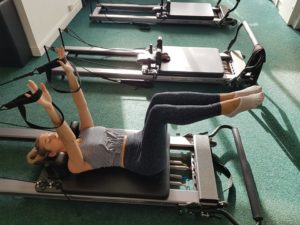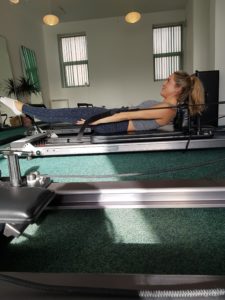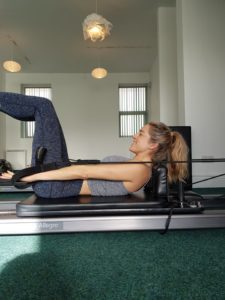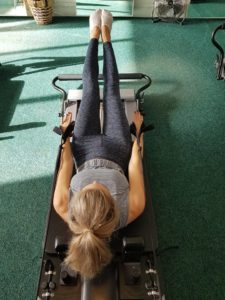In this blog series, we are breaking down the Reformer, taking all the exercises you know and love to hate, and giving you the why and the how to perfect your technique as well as some things to think about the next time you tackle a particular exercise.
“Ok so let’s grab the short loops, legs to table top, heels to Pilates V, breath in and as you exhale, sink the chest bone, sink the ribs, reach through the fingertips and as you flex up, reach the legs forward, holding that strong hundred position. Start to pump the arms inhaling two three four, exhale two three four……”
Ah the Pilates Hundred – does it ever get easier? No! Does it remain as effective the 507th time you do it as it was the first time? Yes indeed! The Hundred is one of the cornerstone exercises of a Pilates workout. Can you do Pilates without doing at least a version of the Hundred (adapted for each individual to suit their bodies)? Absolutely not. It comes early on in the workout, its benefits are numerous.
Why you need to be doing The Hundred
- It’s a super way to warm up the body, gets blood pumping and stimulates lymphatic flow around the arms and armpits and collarbones
- It increases abdominal strength
- It teaches us how to breathe deeply and connect the breath to the movements of the exercise
- It helps to increase our thoracic (mid back) flexibility
- It helps to strengthen our hip flexors and abdominals
- It teaches us how to connect the arms to the core
- Most importantly, it helps teach us about lumbopelvic stability while flexing the thoracic spine (rib cage)
Here are some things to keep in mind for your next Hundred:
 Just because it’s called the Hundred, it doesn’t mean you have to do all Hundred!
Just because it’s called the Hundred, it doesn’t mean you have to do all Hundred!
Ok so here is the thing – all one hundred beats is the goal but when you started off with Joe Pilates in his studio, he insisted on a strong effort where you started with 20 and built your way up. So think about perfect form and take it 10 at a time
On the Reformer, the straps are there to support you
By using the straps, we get a lot more feedback than we would get doing the Hundred on the mat but it can be easy to see the straps as a distraction. The straps give you something external to push into and to reach out from. Use the reach into the straps to remind you to slide the shoulder blades down the back, along the ribs towards the back pockets, keeping the tips of the shoulder blades just off the mat, breathing into the tips of the shoulder blades and across the widest part of the mid back.
The straps keep you working into the back and front of the body – you have to control the straps and the carriage which brings more awareness to the movement. If you are not controlled in the pumping of the arms and stable in the centre body, the carriage will move a lot just giving you the feedback that you need to bring a little more control to the work, to focus more on the arms as an extension of the back (like wings).
Use the straps to give you as much feedback as possible and to build your strongest Hundred.
Legs long vs tabletop
In the beginning, we will often start with the legs in tabletop position (legs in the air, knees bent to 90 degrees, knees over the hips, ankles in line with the knees). As you get stronger and more confident with the  exercise, we extend the legs and work with them as low to the ground as possible while still maintaining a strong neutral pelvis to support the core in the front and the back of the body. Whichever position you are working with, remember your basics:
exercise, we extend the legs and work with them as low to the ground as possible while still maintaining a strong neutral pelvis to support the core in the front and the back of the body. Whichever position you are working with, remember your basics:
- The head of the femur (thigh bone) is going to fall into the back of the hip socket and stay there, snuggled in deep to the socket. The more you think about the weight of the bone just dropping into the mat, the less likely you are to grip in your hip flexors.
- As long as you have no issues or injuries that require you to avoid thoracic flexion (lifting your head and shoulders up off the mat) do try to maintain the flexed position. If you find you neck starts to get tired, then you are not ready for the full one hundred beats. The better you get at the exercise, the more aware you will become of sinking your chest bone down, sinking your ribs down and lifting from the abdominal muscles instead of from the neck and shoulders themselves. Always remember that your head always follows your spine, not the other way around.
- If you find your low back start to strain or try to ‘take over’ the exercise, lift your legs higher into the air or bend your legs a little more, your body isn’t quite strong enough for the full Hundred yet, but it will be! You can always rest your legs on the footbar, which will help to train the body to hold this position while giving it a little more support.
B-R-E-A-T-H-E
 The Hundred is a breathing exercise and if you are not pumping air in and out of your lungs as vigorously as you pump your arms, well you are not doing a proper Hundred. Use this warm up to breathe fully and deeply, to get air and blood pumping a little faster around your body. It will also help you to scoop your abs even more and to drop the chest bone and the ribs on each and every full exhale.
The Hundred is a breathing exercise and if you are not pumping air in and out of your lungs as vigorously as you pump your arms, well you are not doing a proper Hundred. Use this warm up to breathe fully and deeply, to get air and blood pumping a little faster around your body. It will also help you to scoop your abs even more and to drop the chest bone and the ribs on each and every full exhale.
- When you inhale, think about reaching your fingertips even further away from you, breathing into the widest part of your back
- Exhale and stay lifted strong, drop the chest bone down into the back of the ribcage and slide the ribs down into the abs a little more every time, while keeping a neutral pelvis.
- Use every second of the count and if you can exhale more than 5 – DO! A full exhale is the key to your Hundred success!


